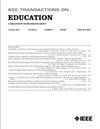Understanding Cybersecurity Education Gaps in Europe
IF 2.1
2区 工程技术
Q2 EDUCATION, SCIENTIFIC DISCIPLINES
引用次数: 0
Abstract
Demand for cybersecurity professionals from industry and institutions is high, driven by an increasing digitization of society and the growing range of potential targets for cyber attacks. However, despite this pressing need a significant shortfall in the number of cybersecurity experts remains and a discrepancy has emerged between the skills introduced through education and those required in professional settings. In this article, a political, economic, social, technological, legal, and environmental (PESTLE) analysis was utilized to explore the factors impacting cybersecurity education in Europe. The PESTLE analysis enabled the categorization of factors affecting cybersecurty education and skills and allowed for cybersecurity professionals to assess the relevance of the factors at a national-level and European-level. Utilizing the concept of modularity from social network analysis, the interconnectivity of factors was also considered. Finally, a European-level stakeholder survey was conducted to verify the findings. As a result of the above process, a lack of societal awareness of cybersecurity was identified as a major challenge to education, along with a lack of EU-level certification. It should be noted that significant differences between factors perceived as impacting cybersecurity education were found between countries suggesting a need for local solutions to the problem.了解欧洲的网络安全教育差距
由于社会日益数字化,网络攻击的潜在目标范围不断扩大,因此行业和机构对网络安全专业人员的需求很高。然而,尽管需求迫切,但网络安全专家的数量仍然严重不足,而且通过教育获得的技能与专业环境所需的技能之间出现了差距。本文利用政治、经济、社会、技术、法律和环境 (PESTLE) 分析来探讨影响欧洲网络安全教育的因素。通过 PESTLE 分析,对影响网络安全教育和技能的因素进行了分类,使网络安全专业人员能够评估这些因素在国家和欧洲层面的相关性。利用社会网络分析中的模块化概念,还考虑了各因素之间的相互关联性。最后,还进行了一次欧洲层面的利益相关者调查,以验证调查结果。上述过程的结果表明,社会缺乏网络安全意识以及缺乏欧盟级认证是教育面临的主要挑战。值得注意的是,各国认为影响网络安全教育的因素之间存在显著差异,这表明需要采取本地解决方案来解决这一问题。
本文章由计算机程序翻译,如有差异,请以英文原文为准。
求助全文
约1分钟内获得全文
求助全文
来源期刊

IEEE Transactions on Education
工程技术-工程:电子与电气
CiteScore
5.80
自引率
7.70%
发文量
90
审稿时长
1 months
期刊介绍:
The IEEE Transactions on Education (ToE) publishes significant and original scholarly contributions to education in electrical and electronics engineering, computer engineering, computer science, and other fields within the scope of interest of IEEE. Contributions must address discovery, integration, and/or application of knowledge in education in these fields. Articles must support contributions and assertions with compelling evidence and provide explicit, transparent descriptions of the processes through which the evidence is collected, analyzed, and interpreted. While characteristics of compelling evidence cannot be described to address every conceivable situation, generally assessment of the work being reported must go beyond student self-report and attitudinal data.
 求助内容:
求助内容: 应助结果提醒方式:
应助结果提醒方式:


